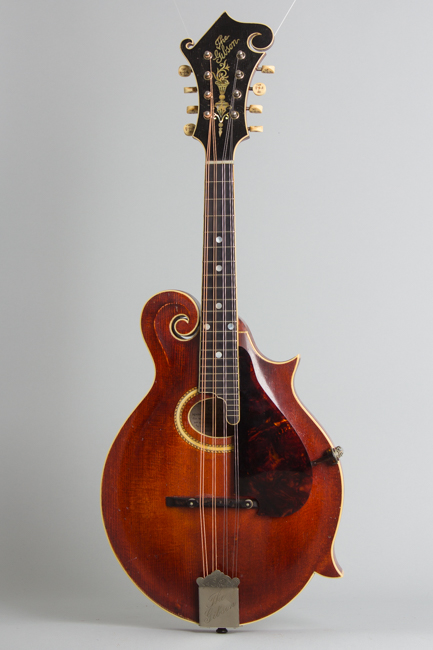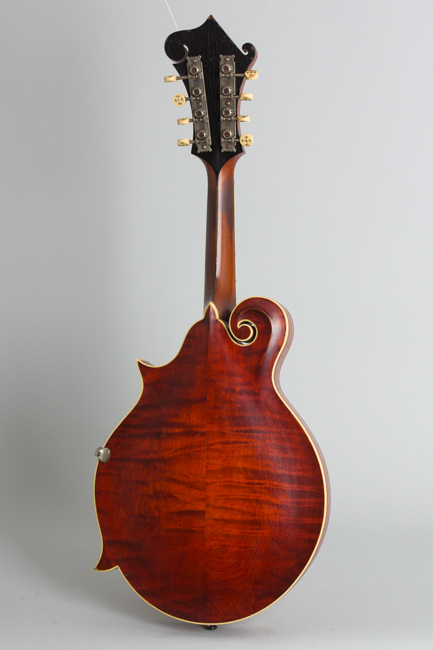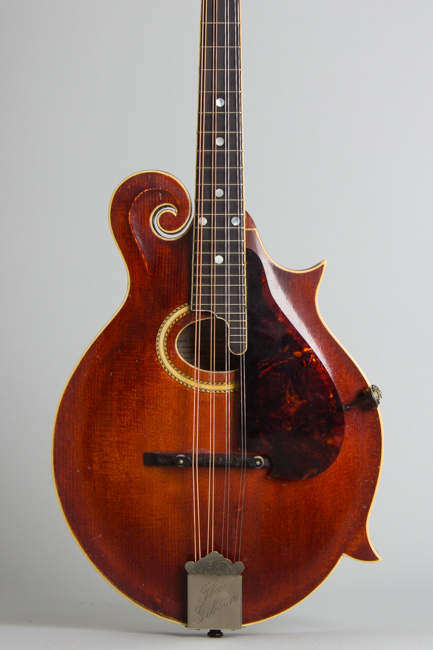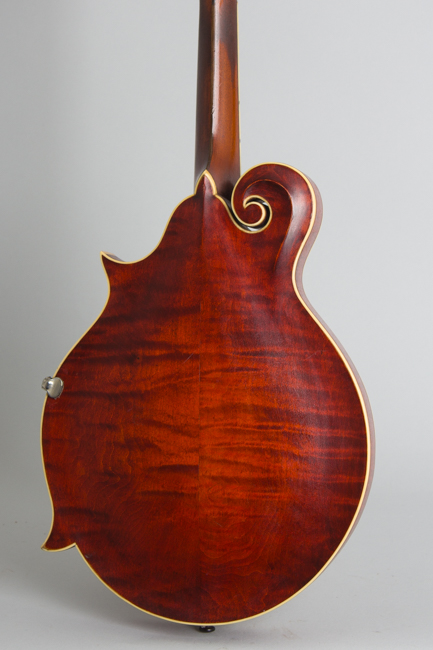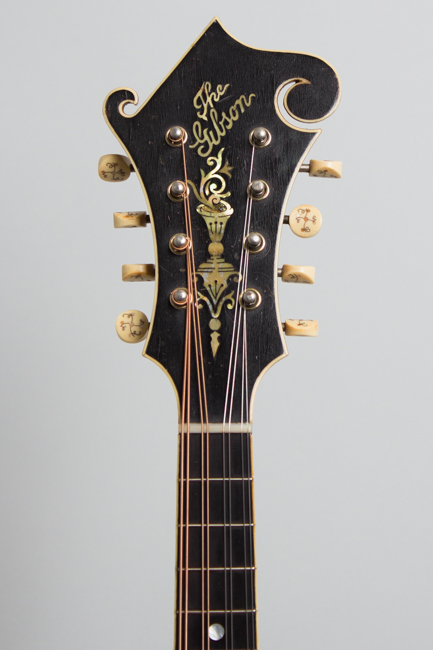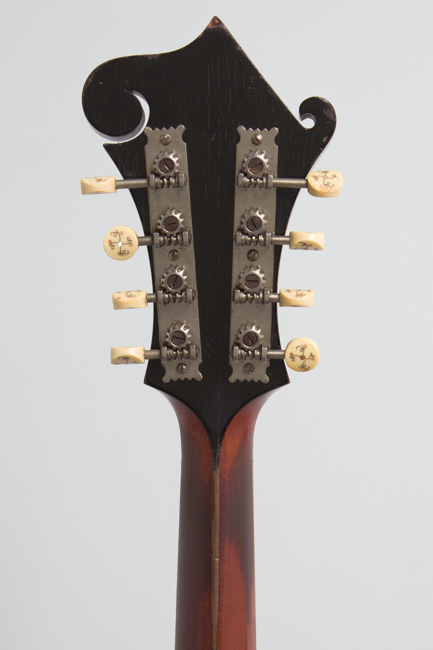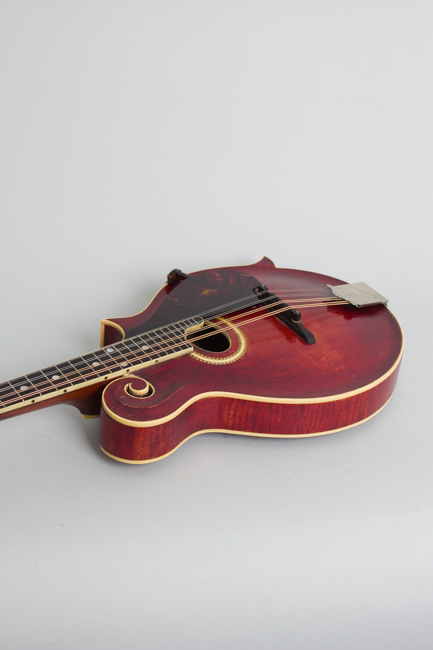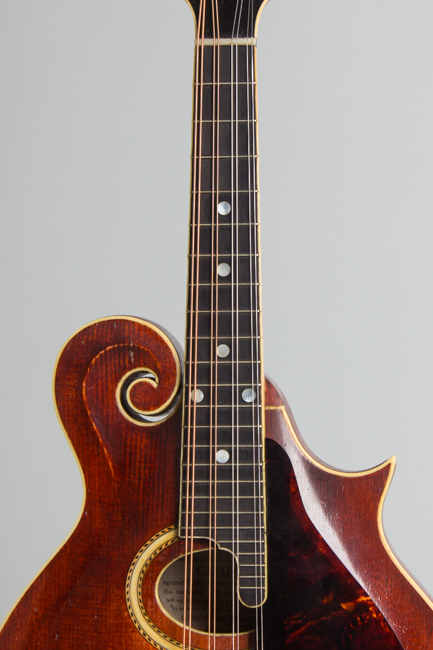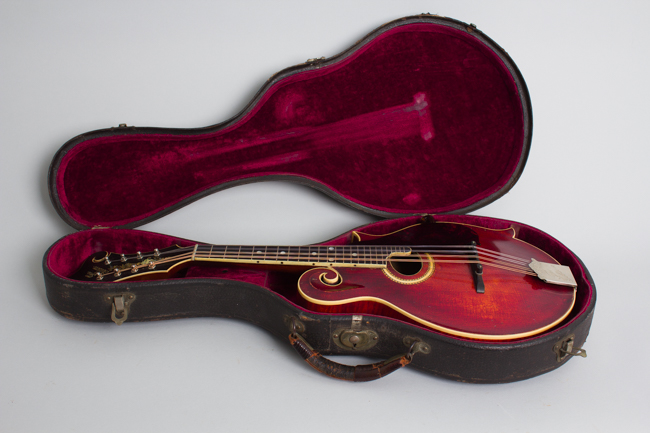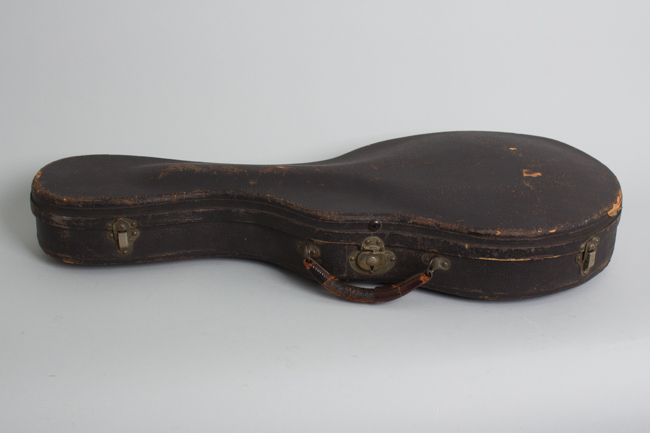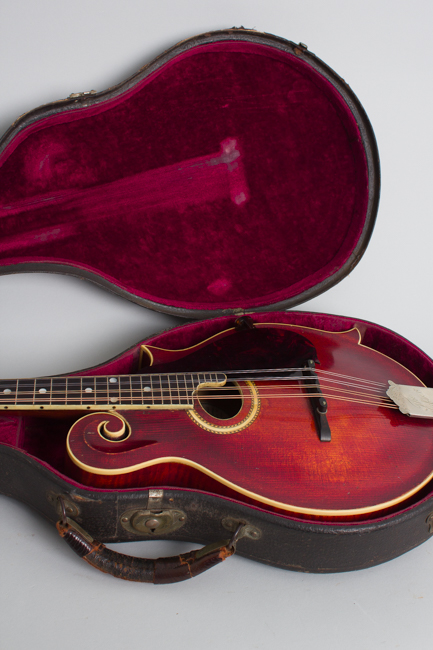Gibson F-4 Carved Top Mandolin (1913)
Gibson F-4 Model Carved Top Mandolin (1913), made in Kalamazoo, Michigan, serial # 20814, sunburst varnish finish, maple back and sides, spruce top; mahogany neck with ebony fingerboard, original black hard shell case.
Just over 110 years ago this early two-point F-4 was Gibson's top of the line mandolin and company's flagship instrument. This one has seen some use but remains a lovely Mandolin nonetheless. It dates to early/mid-1913, not too long after the scroll-body F-4 had been fully perfected from its earlier 3-point body form. In either mode it was an utterly distinctive creation, by almost any standard the finest mandolin in the world at the time. With a sharper neck angle than the "aught year" models Gibson mandolins of this period offered more volume and a more powerful tone than before. This combined with an aggressive sales policy insured the company was able to increasingly dominate the market for mando-family instruments through the 1910s.
The F-4 is an elegant but not overly decorated instrument. The single layer binding on the body, neck and headstock is grained ivoroid. The double-flowerpot pearl and abalone inlay on the headstock under the "The Gibson" logo has some particularly dramatic green abalone in the "flower" section. Combined with the inlaid Handel tuner buttons this gives the F-4 a particular Art Nouveau grace and class. The 2-piece maple back has a nice flame figure as do the sides. The mahogany neck is fairly slim with a strong "V" profile.
This instrument would have been the top choice for any virtuoso mandolinist in the just pre-WWI era, and today is still an iconic creation and a superb instrument with a bright yet robust sound. It has seen well over a century of use but like a fine old violin is still a wonderful instrument to play.
Overall length is 26 in. (66 cm.), 10 in. (25.4 cm.) width, and 1 1/2 in. (3.8 cm.) in depth, measured at side of rim. Scale length is 14 in. (356 mm.). Width of nut is 1 1/4 in. (32 mm.).
This F-4 shows some wear and minor repair from 110 years on Earth but looks, plays and sounds lovely. The original thin varnish finish has micro-checking over the entire instrument with a collection of mostly minor dings, dents, and scrapes. Though obviously played there is little of the common pickwear on the top. The finish shows a few minor touch-ups but no major overfinishing, with some small spots filled in on the back and an over-finished spot to the top between the scroll and the sound hole. The finish on the back of the neck is heavily worn to the wood over much of its length on the treble side and to the 5th fret area on the bass side.
There are no cracks visible, as is typical a couple of spots along the back/side seams show signs of possible re-gluing long ago. The hardware is original except for a later 1920s style adjustable bridge and a perfect repro pickguard. The tuners, tailpiece and pickguard clamp bracket remain original. The fingerboard shows less wear than one might expect; the fretwire appears original; is possible this is an ancient refret with original wire (it is possibly Gibson did this in the 1920s) and the original pearl nut is still intact. This a very sweet and enjoyable mandolin to play with a sparkling sound and comfortable action. It lives in the original shaped HSC, worn but solid. Overall Excellent - Condition.
Just over 110 years ago this early two-point F-4 was Gibson's top of the line mandolin and company's flagship instrument. This one has seen some use but remains a lovely Mandolin nonetheless. It dates to early/mid-1913, not too long after the scroll-body F-4 had been fully perfected from its earlier 3-point body form. In either mode it was an utterly distinctive creation, by almost any standard the finest mandolin in the world at the time. With a sharper neck angle than the "aught year" models Gibson mandolins of this period offered more volume and a more powerful tone than before. This combined with an aggressive sales policy insured the company was able to increasingly dominate the market for mando-family instruments through the 1910s.
The F-4 is an elegant but not overly decorated instrument. The single layer binding on the body, neck and headstock is grained ivoroid. The double-flowerpot pearl and abalone inlay on the headstock under the "The Gibson" logo has some particularly dramatic green abalone in the "flower" section. Combined with the inlaid Handel tuner buttons this gives the F-4 a particular Art Nouveau grace and class. The 2-piece maple back has a nice flame figure as do the sides. The mahogany neck is fairly slim with a strong "V" profile.
This instrument would have been the top choice for any virtuoso mandolinist in the just pre-WWI era, and today is still an iconic creation and a superb instrument with a bright yet robust sound. It has seen well over a century of use but like a fine old violin is still a wonderful instrument to play.
Overall length is 26 in. (66 cm.), 10 in. (25.4 cm.) width, and 1 1/2 in. (3.8 cm.) in depth, measured at side of rim. Scale length is 14 in. (356 mm.). Width of nut is 1 1/4 in. (32 mm.).
This F-4 shows some wear and minor repair from 110 years on Earth but looks, plays and sounds lovely. The original thin varnish finish has micro-checking over the entire instrument with a collection of mostly minor dings, dents, and scrapes. Though obviously played there is little of the common pickwear on the top. The finish shows a few minor touch-ups but no major overfinishing, with some small spots filled in on the back and an over-finished spot to the top between the scroll and the sound hole. The finish on the back of the neck is heavily worn to the wood over much of its length on the treble side and to the 5th fret area on the bass side.
There are no cracks visible, as is typical a couple of spots along the back/side seams show signs of possible re-gluing long ago. The hardware is original except for a later 1920s style adjustable bridge and a perfect repro pickguard. The tuners, tailpiece and pickguard clamp bracket remain original. The fingerboard shows less wear than one might expect; the fretwire appears original; is possible this is an ancient refret with original wire (it is possibly Gibson did this in the 1920s) and the original pearl nut is still intact. This a very sweet and enjoyable mandolin to play with a sparkling sound and comfortable action. It lives in the original shaped HSC, worn but solid. Overall Excellent - Condition.
